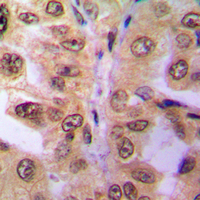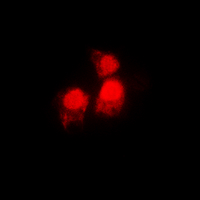Anti-SIAH2 Antibody
Rabbit polyclonal antibody to SIAH2
- 产品详情
- 实验流程
- 背景知识
Application
| WB, IF/IC, IHC |
|---|---|
| Primary Accession | O43255 |
| Other Accession | Q06986 |
| Reactivity | Human, Mouse, Rat, Zebrafish |
| Host | Rabbit |
| Clonality | Polyclonal |
| Calculated MW | 34615 Da |
| Gene ID | 6478 |
|---|---|
| Other Names | E3 ubiquitin-protein ligase SIAH2; Seven in absentia homolog 2; Siah-2; hSiah2 |
| Target/Specificity | KLH-conjugated synthetic peptide encompassing a sequence within the C-term region of human SIAH2. The exact sequence is proprietary. |
| Dilution | WB~~WB (1/500 - 1/1000), IHC (1/100 - 1/200), IF/IC (1/100 - 1/500) IF/IC~~N/A IHC~~WB (1/500 - 1/1000), IHC (1/100 - 1/200), IF/IC (1/100 - 1/500) |
| Format | Liquid in 0.42% Potassium phosphate, 0.87% Sodium chloride, pH 7.3, 30% glycerol, and 0.09% (W/V) sodium azide. |
| Storage | Store at -20 °C.Stable for 12 months from date of receipt |
| Name | SIAH2 |
|---|---|
| Function | E3 ubiquitin-protein ligase that mediates ubiquitination and subsequent proteasomal degradation of target proteins (PubMed:11483518, PubMed:19224863, PubMed:9334332). E3 ubiquitin ligases accept ubiquitin from an E2 ubiquitin-conjugating enzyme in the form of a thioester and then directly transfers the ubiquitin to targeted substrates (PubMed:11483518, PubMed:19224863, PubMed:9334332). Mediates E3 ubiquitin ligase activity either through direct binding to substrates or by functioning as the essential RING domain subunit of larger E3 complexes (PubMed:11483518, PubMed:19224863, PubMed:9334332). Triggers the ubiquitin-mediated degradation of many substrates, including proteins involved in transcription regulation (GPS2, POU2AF1, PML, NCOR1), a cell surface receptor (DCC), an antiapoptotic protein (BAG1), and a protein involved in synaptic vesicle function in neurons (SYP) (PubMed:11483518, PubMed:19224863, PubMed:9334332). Mediates ubiquitination and proteasomal degradation of DYRK2 in response to hypoxia (PubMed:22878263). It is thereby involved in apoptosis, tumor suppression, cell cycle, transcription and signaling processes (PubMed:11483518, PubMed:19224863, PubMed:22878263, PubMed:9334332). Has some overlapping function with SIAH1 (PubMed:11483518, PubMed:19224863, PubMed:9334332). Triggers the ubiquitin-mediated degradation of TRAF2, whereas SIAH1 does not (PubMed:12411493). Promotes monoubiquitination of SNCA (PubMed:19224863). Regulates cellular clock function via ubiquitination of the circadian transcriptional repressors NR1D1 and NR1D2 leading to their proteasomal degradation (PubMed:26392558). Plays an important role in mediating the rhythmic degradation/clearance of NR1D1 and NR1D2 contributing to their circadian profile of protein abundance (PubMed:26392558). Mediates ubiquitination and degradation of EGLN2 and EGLN3 in response to the unfolded protein response (UPR), leading to their degradation and subsequent stabilization of ATF4 (By similarity). Also part of the Wnt signaling pathway in which it mediates the Wnt-induced ubiquitin- mediated proteasomal degradation of AXIN1. |
| Cellular Location | Cytoplasm. Nucleus Note=Predominantly cytoplasmic. Partially nuclear |
| Tissue Location | Widely expressed at low level. |
Research Areas
For Research Use Only. Not For Use In Diagnostic Procedures.
Application Protocols
Provided below are standard protocols that you may find useful for product applications.
BACKGROUND
KLH-conjugated synthetic peptide encompassing a sequence within the C-term region of human SIAH2. The exact sequence is proprietary.
终于等到您。ABCEPTA(百远生物)抗体产品。
点击下方“我要评价 ”按钮提交您的反馈信息,您的反馈和评价是我们最宝贵的财富之一,
我们将在1-3个工作日内处理您的反馈信息。
如有疑问,联系:0512-88856768 tech-china@abcepta.com.
¥ 1,500.00
Cat# AP60394























 癌症的基本特征包括细胞增殖、血管生成、迁移、凋亡逃避机制和细胞永生等。找到癌症发生过程中这些通路的关键标记物和对应的抗体用于检测至关重要。
癌症的基本特征包括细胞增殖、血管生成、迁移、凋亡逃避机制和细胞永生等。找到癌症发生过程中这些通路的关键标记物和对应的抗体用于检测至关重要。 为您推荐一个泛素化位点预测神器——泛素化分析工具,可以为您的蛋白的泛素化位点作出预测和评分。
为您推荐一个泛素化位点预测神器——泛素化分析工具,可以为您的蛋白的泛素化位点作出预测和评分。 细胞自噬受体图形绘图工具为你的蛋白的细胞受体结合位点作出预测和评分,识别结合到自噬通路中的蛋白是非常重要的,便于让我们理解自噬在正常生理、病理过程中的作用,如发育、细胞分化、神经退化性疾病、压力条件下、感染和癌症。
细胞自噬受体图形绘图工具为你的蛋白的细胞受体结合位点作出预测和评分,识别结合到自噬通路中的蛋白是非常重要的,便于让我们理解自噬在正常生理、病理过程中的作用,如发育、细胞分化、神经退化性疾病、压力条件下、感染和癌症。








